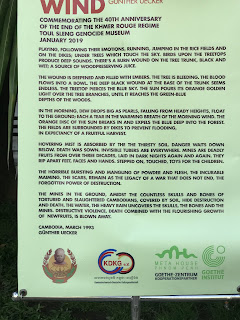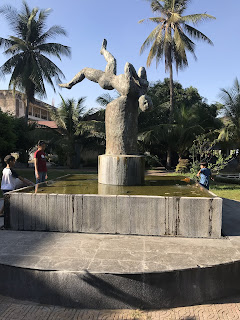S-21, the killing Machine of the Khmer Rouge
It is now 11pm on Sunday 17th. We spent most of last night and this morning suffering the consequences of probably some contaminated ice in a very highly rated restaurant. A diet of PeptoBismol shooters, and Ramen soup noodles helped replenish enough electrolytes to allow us to venture out around 2pm.
A tuk tuk ride across town brought us to the Tuol Sleng Genocide Museum, also known as S-21. A school converted by the Khmer Rouge into a secret prison in the heart of the city, it was one of 200 scattered around the country and served.as a torture unit where prisoners were kept alive long enough to provide forced confessions of their “crimes” against the State. These crimes could be for things as simple as wearing glasses, a sign of an intellectual. Artists, the better educated and those with skills like physicians were fair game.
The original school consisted of 4 blocks of 3 story classrooms which were converted into torture rooms and prison cells. Internal walls of brick and wood were built within the upper lower and middle classrooms to provide tiny cells for 2 that would barely have space for one person.
Under various guises, the “educated” and wealthier members of the nation were brought here in order to extract confessions using the most gruesome methods imaginable. Over the course of about 4 years in the 1970’s prisoners who did not die here were removed to the Killing Fields of Choeung Ek, an orchard some 17 km from town. There they met horrendous deaths before being buried in mass graves. It is estimated that up to 20,000 people passed through the doors of this complex over a 4 year period with only 12 survivors.
Estimates range from well over a million deaths with up to one third of the entire population killed.
This was on top of the previous US Secret War against Cambodia when they dropped more bombs on Cambodia and Laos between 1969 and 1971 than all the bombs dropped in WWII. This and other factors lead to the rise of the Regime of Pol Pot and the Khmer Rouge. Their goal, simply put was to establish a classless agrarian society with everyone being equal but it ultimately became nothing more than an extermination machine.
In that respect it is not so different from the brutal actions that took place in countries like Nicaragua and Guatemala, but what sets it apart is the sheer scale of the killings. Also, while news did leak out to the world, various governments were duped into thinking it was all propaganda and lies designed to tarnish their perceived image of Pol Pot.
Our tour of the grounds took us over 2 hours, with audio guides providing graphic testimonies of the few survivors as well as descriptions of the conditions. The buildings contained 100’s of images of prisoner “ mug shots” as well as graphic images of corpses shackled to beds.
At one point on my journey through the buildings I took a brief break outside and watched some small local children engaged in pick up soccer with a small ball, a reminder that, before this complex became a death machine, it was a playground. While signs on the grounds reminded visitors to be dignified and respectful, I thought the kids were doing just what kids do in a school playground.
A final set of rooms in building D showed the artistic renderings of survivors. Many depicted the crowded cell conditions of prisoners shackled to one another. Many more showed the tortures they endured. Descriptions described attempts at suicide by various means in order to escape their suffering.
I found myself unable to complete the journey through the final floors of the last building and so I sought refuge in the gardens surrounding the Memorial to the Victims, the names of many, etched in gold plate on various plaques. A final image that caught my eye was a sprinkler watering the grass with water cascading onto a memorial stone as if nature itself was shedding tears of sorrow over the lives lost.
Never Again is an oft repeated phrase that is used all too loosely by various world governments as these situations come to light. And yet the reality is that Till Next Time seems more in keeping with the reality of the human race.
A tuk tuk ride across town brought us to the Tuol Sleng Genocide Museum, also known as S-21. A school converted by the Khmer Rouge into a secret prison in the heart of the city, it was one of 200 scattered around the country and served.as a torture unit where prisoners were kept alive long enough to provide forced confessions of their “crimes” against the State. These crimes could be for things as simple as wearing glasses, a sign of an intellectual. Artists, the better educated and those with skills like physicians were fair game.
The original school consisted of 4 blocks of 3 story classrooms which were converted into torture rooms and prison cells. Internal walls of brick and wood were built within the upper lower and middle classrooms to provide tiny cells for 2 that would barely have space for one person.
Under various guises, the “educated” and wealthier members of the nation were brought here in order to extract confessions using the most gruesome methods imaginable. Over the course of about 4 years in the 1970’s prisoners who did not die here were removed to the Killing Fields of Choeung Ek, an orchard some 17 km from town. There they met horrendous deaths before being buried in mass graves. It is estimated that up to 20,000 people passed through the doors of this complex over a 4 year period with only 12 survivors.
Estimates range from well over a million deaths with up to one third of the entire population killed.
This was on top of the previous US Secret War against Cambodia when they dropped more bombs on Cambodia and Laos between 1969 and 1971 than all the bombs dropped in WWII. This and other factors lead to the rise of the Regime of Pol Pot and the Khmer Rouge. Their goal, simply put was to establish a classless agrarian society with everyone being equal but it ultimately became nothing more than an extermination machine.
In that respect it is not so different from the brutal actions that took place in countries like Nicaragua and Guatemala, but what sets it apart is the sheer scale of the killings. Also, while news did leak out to the world, various governments were duped into thinking it was all propaganda and lies designed to tarnish their perceived image of Pol Pot.
Our tour of the grounds took us over 2 hours, with audio guides providing graphic testimonies of the few survivors as well as descriptions of the conditions. The buildings contained 100’s of images of prisoner “ mug shots” as well as graphic images of corpses shackled to beds.
At one point on my journey through the buildings I took a brief break outside and watched some small local children engaged in pick up soccer with a small ball, a reminder that, before this complex became a death machine, it was a playground. While signs on the grounds reminded visitors to be dignified and respectful, I thought the kids were doing just what kids do in a school playground.
A final set of rooms in building D showed the artistic renderings of survivors. Many depicted the crowded cell conditions of prisoners shackled to one another. Many more showed the tortures they endured. Descriptions described attempts at suicide by various means in order to escape their suffering.
I found myself unable to complete the journey through the final floors of the last building and so I sought refuge in the gardens surrounding the Memorial to the Victims, the names of many, etched in gold plate on various plaques. A final image that caught my eye was a sprinkler watering the grass with water cascading onto a memorial stone as if nature itself was shedding tears of sorrow over the lives lost.
Never Again is an oft repeated phrase that is used all too loosely by various world governments as these situations come to light. And yet the reality is that Till Next Time seems more in keeping with the reality of the human race.















This comment has been removed by a blog administrator.
ReplyDelete